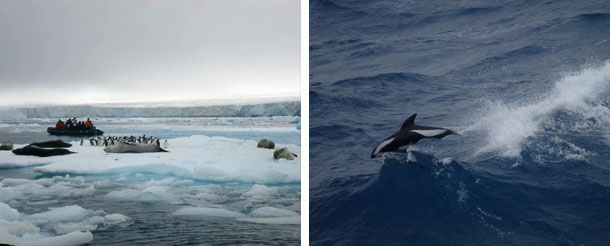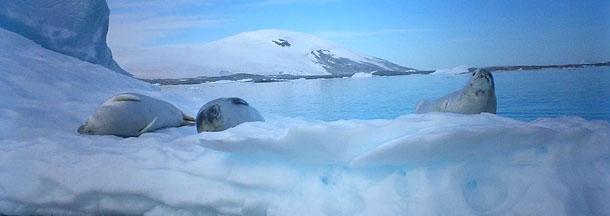The Sunday Telegraph - Ice, ethics and the call of the wild in Antarctica
May 4, 2007
Seeing the Big Five wonders of the Last Continent is certainly thrilling, but visiting the region poses a dilemma for travellers.

It doesn’t sound like much of a holiday. Antarctica is the coldest, driest and windiest place on earth. But the southern polar cap is becoming increasingly en vogue and the number of visitors has doubled here in the past three years to nearly 30,000.
Tucked away on the opposite side of the globe, the world’s last great wilderness is now accessible and relatively affordable for anyone seeking Antarctica’s “Big Five”: whales, seals, penguins, albatross and possibly the continent’s greatest draw – the ice.
Much of the wonder of Antarctica lies in the great swathes of snowfields scoured by a blur of wind, the pitted glaciers stealthily heading seaward and the colossal tabular icebergs shifting across a sea of glassy ice shards. The extreme climate and inhospitable terrain have meant the continent has never been inhabited, one of the things that makes it unique in this congested world.
The most popular gateway to the continent is the port of Ushuaia, at the southern tip of Argentina. I boarded the smallest ship in the harbour, the cardinal-red MS Explorer, which was one of the first passenger ships to take visitors to Antarctica in 1970. It is a good size – carrying 100 passengers – with three tiers of open deck space.
Both factors are important in choosing a boat. The highlights of such a trip include standing on deck with a pair of binoculars looking for whales and Wandering Albatross, as well as boarding the inflatable Zodiacs for micro-cruises around the ice floes or for transfers to shore for more intimate wildlife viewing.
Explorer attracted mostly English-speaking passengers, mainly from the UK, Ireland and Australia. Some had been planning the trip for a decade, a do-before-they-die mission. Others wanted to notch up their seventh continent. Many wanted to add Antarctica to their photo albums. But regardless of the reason for coming, everyone had a strong spirit of adventure and that common ground was important. As a small group in a confined space, fellow passengers are an integral part of the trip. Meals are taken communally and public spaces become very sociable. If you come here seeking solitude, you must pointedly stick your nose into your Shackleton biography.
We left Ushuaia in high spirits on a cold grey day, forging east into the Beagle Channel and beyond into the dreaded Drake Passage. Half the time is spent reaching and returning from the continent – and that can involve some rough stuff – for almost 600 miles. Storms around Cape Horn are notorious and although we suffered 20-foot rolling waves and lashing winds, we were assured this was a very average crossing. For those who surfaced, there were four expert lecturers on board talking to us about the birds, mammals and rocks we might see. We heard numerous tales of unsung polar heroes who lost their fingers, toes and sometimes their lives in the quest to plant a flag on uncharted territory.
Around 60º South, we crossed the Antarctic Convergence, an important threshold where warmer northern waters meet cooler southern seas. This clash gives rise to an abundance of krill, the crustaceans that form the staple diet of many Antarctic species. Here, we saw fin and minke whales and our first penguins, porpoising alongside the boat. I watched a black-browed albatross coast above the churning waves, effortlessly gliding on the high winds.
After the queasy crossing, it was with some relief that we arrived at the Antarctic Peninsula, a tail of land that looks like the last flick of the Andes mountain range. The high peaks and deep channels make for much more sheltered navigation. This is the most heavily visited part of Antarctica because it is the warmest and wettest region.
There are hyperactive colonies of penguins squabbling over stones (for their nests), chicks chasing parents for a feed and all of them squirting out bright pink, stinky guano. Rocks are also splattered in yellow and green lichens, a profusion of colour in this land of ice. Hauled out of the sea are snoozing Weddell seals, snorting southern elephant seals and fur seals lolloping across the beaches.
Over the next four days, we visited eight landing sites around the peninsula, ranging from extinct ashen volcanic cones to snow-free pebble beaches to rusting old whaling stations and the British base at Port Lockroy. From the decks, we spotted humpback whales feeding: they blow a ring of bubbles, which rises to the surface netting thousands of krill. The whales follow the bubble-net upwards, gulping down their prey, and emerging head-first out of the water.
We boarded the sturdy Zodiacs to tour around Brown Bluff on the Tabarin Peninsula. Worried young Gentoo penguins were taking to the water for the first time, with dozens of lethal leopard seals lying in wait. It was easy pickings for the seals. We watched one patrol a penguin-laden iceberg, come in for the kill, snap up one of the inexperienced fledgelings and aggressively slam the poor penguin back and forth on the surface of the water. It certainly made for uneasy viewing.
We then rounded the peninsula and charted south towards the narrow Lemaire Channel, where the world whitened, icebergs moved stealthily like pieces on a chessboard and the light dazzled on our first cloudless day. The floating ice crowded the sea like almighty mythological creatures, before groaning and creaking as they melted away, breaking apart, collapsing under their own weight.
Yet it is not just the wilderness that makes Antarctica unique. It is also the politics. No one owns the region and anybody can come here. The failing of this arrangement is that no one is responsible for the continent’s wellbeing. The International Association of Antarctica Tour Operators (IAATO) outlines sensible guidelines on managing visitors but it is only a voluntary organisation. For now, it is certainly better than nothing and anyone planning a visit should make sure their operator either subscribes to IAATO or has a good reason not to.
Antarctica does present a dilemma for anyone who cares about natural world. Visitors undoubtedly make an impact on the environment, from the fuel we burn getting here, to our very footsteps and potential shipping accidents. The last danger became evident this year; the MS Nordkapp cruise ship hit rocks near Deception Island and spilt diesel oil into the bay.
Rick Atkinson, base manager at Port Lockroy, has been working in Antarctica for more than 20 years. He believes it’s only a matter of time before lasting damage is done to the region. “Last year, 10,500 tourists visited Port Lockroy. This year, we’re expecting 50 per cent more. I don’t believe that trend is at all sustainable,” he says.
Stephen Ansfee, the expedition leader on MS Explorer, offers some sense of hope, however. “If we can create ambassadors for Antarctica on these trips, that will only help secure the future of this place. Who wants to get involved in protecting something they haven’t even seen?”
It’s a tough call. No matter how good those Attenborough documentaries are, Antarctica in reality – looking across the loose ice pack and deep hummocky floes, that buffeting, drying wind against your face, the sense of unbelonging – is something else entirely. The Last Continent’s future may now depend on just how many respond to the call of the wild.





